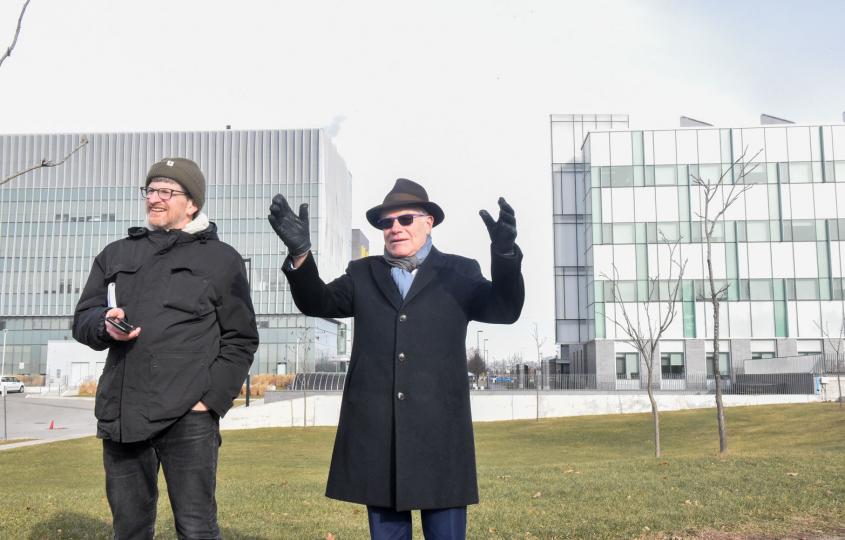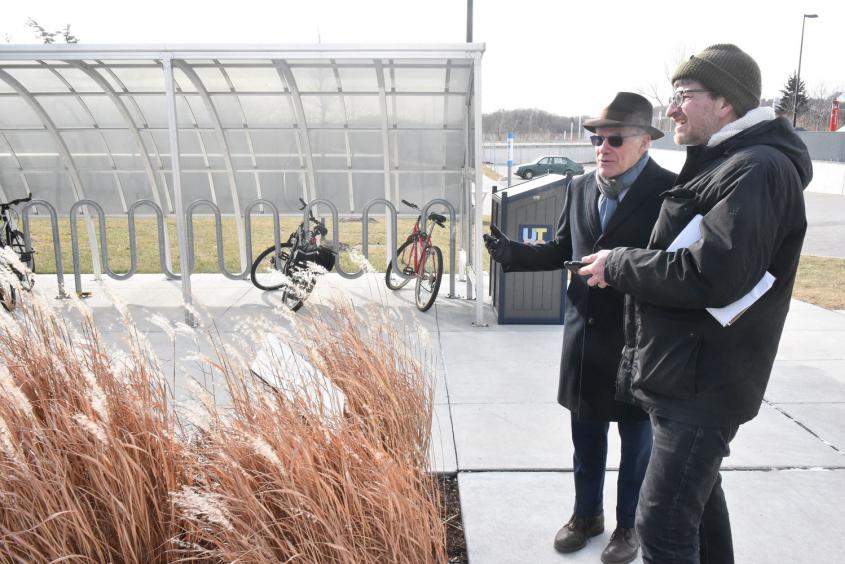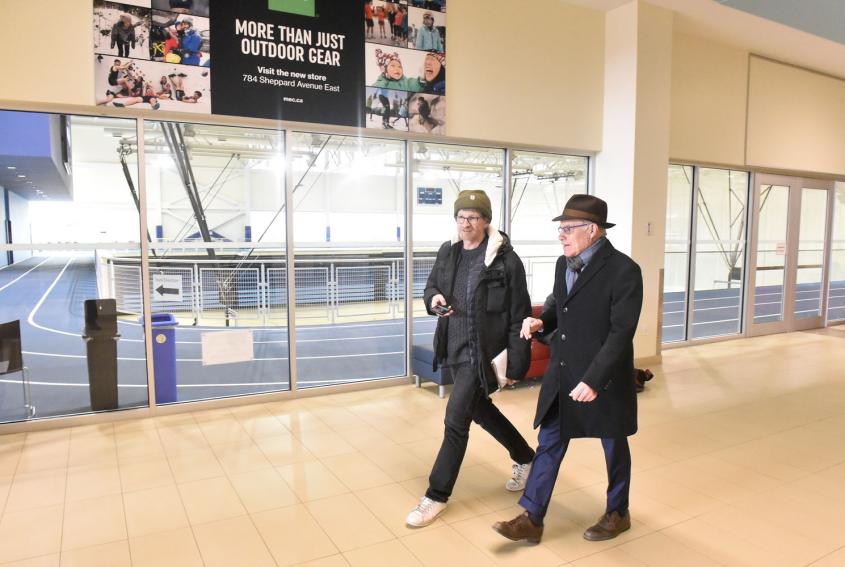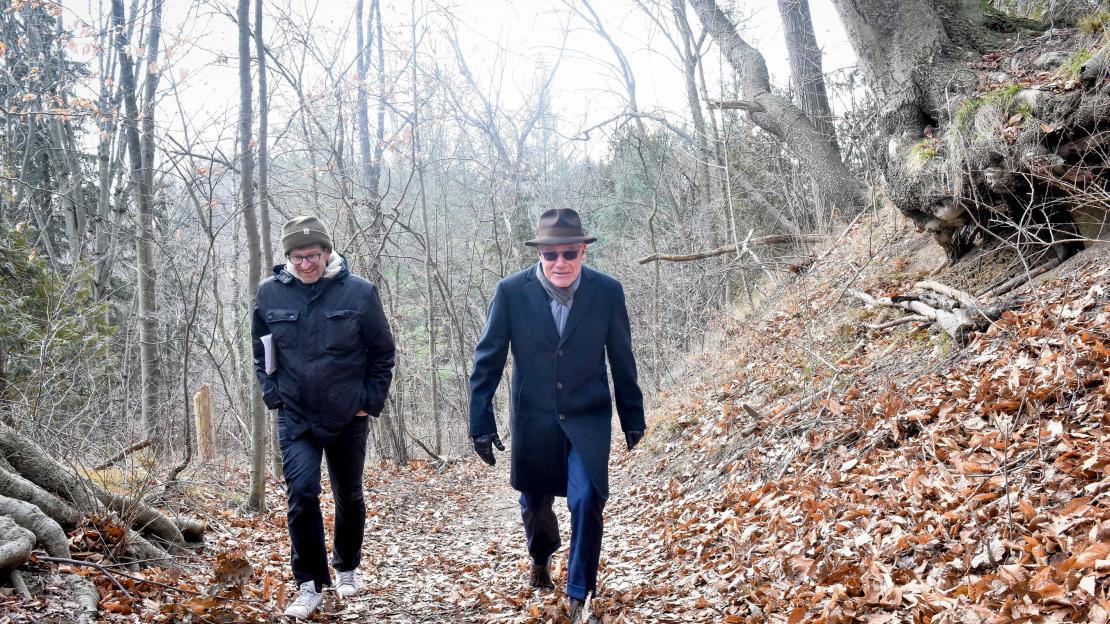Rather than sit in a stuffy meeting room or office, our principal is fond of getting up and taking his colleagues—and students—for walks. As he wraps up his time at U of T Scarborough, we took him for a tour of the campus to reflect on the last few years and what the future holds.
“Here is the sun.”
On a raw winter morning just shy of the fourth anniversary of his appointment as principal, Bruce Kidd pauses during one of his signature walking meetings at a cluster of plaques in between the Arts and Administrative building and the Science Wing. A U of T Scarborough Canada 150 project created by astrophysics faculty and students, the plaques indicate the positions of the solar system’s planets relative to the sun, and one another, on July 1, 1867. The scale, he explains, is 1 millimeter to 10,000 kilometres. The plaques for the inner ring planets are mostly in this area, the home of portable buildings that are slated to be retired.
“There’s Mercury over here,” he says, adding, “We’ve got [others] down in the valley. And because these guys have a great sense of humour, there’s a research station in Nunavut [where] they’ve got [another] one.” It marks the location of the next closest planet to our solar system, and we think makes this the world’s largest to-scale model.
Kidd, who has served as U of T Scarborough’s 10th principal and will retire this spring, admires how these young scholars found an imaginative way to bring an other-worldly discipline down to earth, so to speak. But he clearly enjoys the subtle subtext of the installation, which situates the campus at the centre of the sprawling arrangement of not-so-celestial bodies that is the University of Toronto.
Like many U of T veterans, Kidd spent much of his career on the St. George campus, which has long seen itself as not only the centre but also the primary source of university’s energy. Yet in four years at a campus that is physically larger than both St. George and Mississauga, Kidd (who once lived in Scarborough) has come to recognize that the city’s future is taking shape in the diverse neighbourhoods that have grown up around the campus and help define its student body.
Scarborough’s communities, he says, run the gamut from affluent neighbourhoods to lower income enclaves populated by recent immigrants and refugees. The region functions as a kind of crucible, its 650,000 residents dedicated to the complicated business of “integrating people of difference” in a single urban community, Kidd observes.
“While there’s economic poverty, the people in Scarborough are not impoverished in other ways, in terms of culture, the education they came with, entrepreneurship, and a commitment to making a better world for their children and themselves. Our students are very much a part of that. They’re just amazing.”

Bruce Kidd first came to public view as Canada’s premier distance runner in the early 1960s. He was twice voted Canada’s Male Athlete of the Year and was a member of Canada’s Olympic team in the 1964 Tokyo summer games. Kidd finished his undergraduate degree at U of T not long after returning from Japan.
At 74, Kidd has the spry and fit appearance of someone at least a decade younger. He remains a fitness buff who walks, bikes and does Pilates regularly. One of his favorite routes at U of T Scarborough is a stepped path that winds down from behind the Humanities Wing into the valley, a bucolic landscape carved out by Highland Creek.
The path, Kidd allows, is steep and crumbling in parts, factors that add an element of thrill to a bike ride down through the forested slope. But, he notes, “When you think of people with any kind of mobility challenge, and people who are somewhat fearful of the outdoors, it’s a huge deterrent to visiting the valley.”
For Kidd, the campus lands in the valley represent a complex matrix of memory, institutional achievement and potential. As a youngster growing up in Toronto in the 1950s, he and his brother would travel by streetcar to a YMCA summer day camp near what is today U of T Scarborough. “In terms of postcard views of Toronto, one of the most beautiful is down there about a kilometre, a series of falls surrounded by maples,” he says as we pause near the playing fields.
The land here, subject of the Williams Treaty of 1923 with several Mississauga and Chippewa First Nations, was acquired in 1913 by businessman Miller Lash, and later transferred to the university shortly before the establishment of Scarborough College. It remains a wild and underused space, with deer, fox and beavers, as well as a river where you can see salmon swimming upstream in the spring, that routinely floods adjoining areas (sometimes coming as far as a set of old tennis courts). “It’s a quiet little stream now,” he says as we pause on a bridge. “But after a rainfall, this is a raging torrent that causes nothing but grief.” Pointing to a metal embankment that has succumbed to the creek’s force, Kidd recalls a t-shirt he once saw that said, “Nature bats last.”
During the planning for the 2015 PanAm & Parapan American Games, the U of T bid advocates, which included Kidd (then dean of the School of Physical Health and Education), proposed the valley as a tennis venue. When Toronto won the games, the organizers took up that suggestion for wheelchair tennis, which was the genesis of building a state-of-the-art new facility, higher up from the flood plain. The old courts, Kidd says, are being reclaimed, while an area nearby is being cultivated to grow sweet grass and herbs for smudging ceremonies, as well as demonstration projects for nutritional foods that can be serve in campus outlets. The growing project, he says, is about “integrating multiplicities of the diasporas” that are represented on campus.
We encounter yet another one of the planet plaques. “Here is where Neptune is,” he says, pausing. “You get a sense of how far things are away.”
As we get back to that craggy path, Kidd talks about the plan to better connect this space to that of the campus and the surrounding city beyond. From deep in his coat pocket, Kidd produces architectural diagrams showing plans to reconstruct the path, retrofitting it with switch-backs, a smooth surface material, better lighting and rest stops. The current 20 per cent grade, he notes, will be dialed back to a more manageable 5 per cent. Construction begins this year, and his hope is that the re-engineered path will open up the valley so it can share its magic with even more members of the community. “This is a legacy of my time here that I will be very proud of.”

Wending through a cluster of student residences, Kidd finds himself thinking about food, and the way the campus, in recent years, has sought to encourage first year undergraduates to subsist on something healthier than a diet of mac ‘n cheese and cereal. As part of supports for first-year students living on campus, the student services group arranges buses so they can go to a local supermarket and buy fresh food that can be prepared in residence kitchens.
“For our international students from China, Hong Kong, Korea and other places,” he notes, “they’re so proud of the fact that part of their coming of age is learning to shop and cook for themselves in a foreign culture.”
It’s a reciprocal relationship, of course, as U of T Scarborough, through its multi-disciplinary food studies program, has become increasingly tethered to Scarborough’s vibrant food scene. It’s a domain that has attracted food historians and other experts, including Tyler Cowen, a visiting U.S. economist who declared on his popular blog that Scarborough the “best ethnic food suburb” he had ever encountered.
Such initiatives reveal how the campus has sought to extend its programming links to surrounding neighbourhoods such as Kingston-Orton-Galloway. Kidd notes that new capital expansion programs — some underway and others still in the planning stages — aim to create a physical form to this expanding relationship. When the campus opened in the mid-1960s, the architecture—like that of many universities of the time--reflected the brutalist design of that era, was inward looking.
But new projects, such as Highland Hall, a $52 million, 134,000 sq.-ft. structure that opens this year, aim to recast that orientation. The site is adjacent to a busy transit loop used by 750 buses from three transit agencies each day, serving the campus community and as a transfer point for people travelling around the eastern GTA.
Kidd says the five-storey modular design aspires to create a permeable gateway to the community. “We’re strongly committed to community engagement, accessibility and inclusion.” At a very practical level, it will include a space where all those bus users, who come from both the campus and the surrounding neighbourhood, will be able to wait inside on cold days. Yet another planetary plaque, for Uranus, hovers at the edge of a nearby parking lot.
Highland Hall also represents the latest move to urbanize Military Trail. This ongoing process, Kidd predicts, will gain momentum over the next decade as city and regional transit officials inch forward with plans to transform this precinct into a mobility hub. Two new buildings will be going up north of Ellesmere — a 750-bed residence, another instructional centre. An anticipated LRT loop linking the campus to the subway (via Ellesmere, Morningside and Eglinton East) will attract more institutional and commercial development along Military Trail, including a hotel/conference centre and possibly a shared facilities arts/media/cultural hub.
“We hope to have the LRT in the early 20s,” Kidd says, as he strolls briskly along the busy thoroughfare edged by parking lots. “The idea is for the LRT to wrap around the Scarborough lands and then we can pedestrianize Military Trail. You’ll have a walkable community. It will probably take until 2025 to realize.”
One of the building initiatives Kidd most eagerly anticipates is a proposed Indigenous House, to be situated on the crest of a hill overlooking Ellesmere and the Highland Creek Valley. The goal is to establish a campus centre for Indigenous students and studies as a means of advancing the recommendations of the Truth and Reconciliation Commission.
“Wouldn’t it be fantastic to be here and to look out over this natural area and to be visible as you come down Ellesmere and go up the other side?” he says. “You would have Indigenous House in a visible place as an affirmation of that commitment.” U of T Scarborough’s students, Kidd adds, are keenly aware of the importance of such investments, especially those who’ve come from other countries, either as immigrants or refugees or the children of newcomers.
In fact, a campus committee, which includes the offspring of immigrants and refugees as well as First Nations students, has turned its attention to indigenizing U of T Scarborough and its curricula. Kidd marvels that students from such diverse backgrounds have no difficulty seeing themselves as “the representatives of settler society.” “They of all people know [what it’s like to be shoved aside]. And they don’t close the door the minute they get here. They immediately get the problems of colonization and take the lead in urging more progressive policies.”

Hustling across the parking lot, Kidd and I duck into the balmy foyer for the Toronto Pan Am Sports Centre, the state-of-the-art complex that opened in 2014 for the Games’ swimming and diving competitions. The entrance is buzzing with activity although, as we’re visiting late morning, the pools have yet to begin filling with swimmers. The Centre, jointly owned by U of T Scarborough and the City of Toronto, is not only a major Games legacy but also offers an innovative approach to operating a facility geared at high performance athletes.
In the run-up to the Games, Kidd was part of the steering committee that conceived and negotiated the $205 million facility, built with contributions from the university, the three orders of government and a student levy that covered 17 per cent of the cost. As he moves around a building he knows like the back of his hand, Kidd continues to marvel at its facilities, as if seeing them for the first time.
He pauses at a viewing area overlooking the diving pool, which abuts a smaller pool whose floor can be raised and lowered to suit the needs of the elderly, the disabled and children. “The floor is specially designed to be raised and lowered with a button,” Kidd says. “It can go from a depth of over 4 m to a depth of .89 metres in a matter of seconds.”
Nearby is a two-story space with basketball courts and an elevated track. During free community access hours, he says, the track is so busy it’s “like a platform on the subway.” Below, on this day, the courts are lively. “This looks like pick-up basketball with people who are working off the stress from exams,” Kidd jokes.
He continues: “When we started planning this in 2009, people told us we could never have a university and the city working effectively together with high performance sports,” he recounts. The lessons of a similar facility, the Australian Institute of Sport in Canberra, Australia, loomed large: the dazzling AIS pool is used almost exclusively by a few high-performance athletes.
The vision for the Toronto Pan Am Sports Centre extended further — a space that accommodated everyone from Olympic freestylers to seniors taking aquafit classes. The building was big enough to include not just mainstream sports but also a rock climbing wall, work-out rooms and offices for amateur sport associations. “We put this together and it’s worked really, really well.”
Fast forward a decade or so, he adds, and the Centre will have become an anchor on the west end of a bustling community hub that will spring out of the spaces between Morningside Avenue and older parts of the campus, which, by then, will house 20,000 students, faculty and staff.
Indeed, as we trek back along Military Trail to his office, Kidd finds himself reflecting on this four -year coda at the end of a U of T career that began in 1970.
“I came out here not seeking this opportunity, [but] seeing tremendous initiatives under way,” he muses as a truck rumbles by on its way to the Highland Hall construction site. “I was able to use my platform and, I think, my reputation downtown, both within U of T and within the city, to sing the praises of, and to affirm, that this is an extraordinary place. If you don’t include what’s happening out here, you’re missing something."
